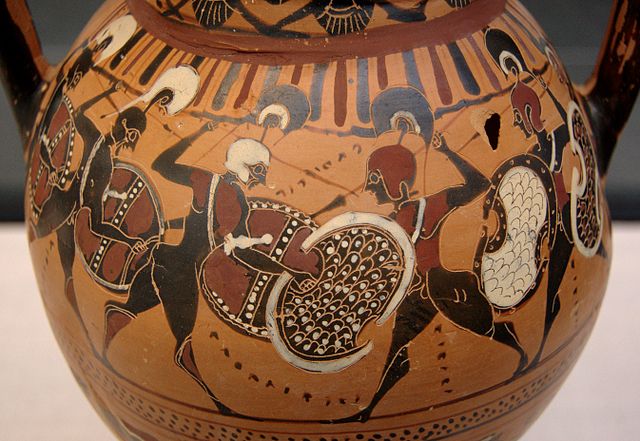The Chigi vase is a Proto-Corinthian olpe, or pitcher, that is the name vase of the Chigi Painter. It was found in an Etruscan tomb at Monte Aguzzo, near Veio, on Prince Mario Chigi’s estate in 1881. The vase has been variously assigned to the middle and late Proto-Corinthian periods and given a date of c. 650–640 BC; it is now in the National Etruscan Museum, Villa Giulia, Rome.
Hoplites on the Chigi vase
Detail
Detail of the Chigi Vase depicting hoplites in action (National Etruscan Museum, Rome)
Judgement of Paris scene
Hoplites were citizen-soldiers of Ancient Greek city-states who were primarily armed with spears and shields. Hoplite soldiers used the phalanx formation to be effective in war with fewer soldiers. The formation discouraged the soldiers from acting alone, for this would compromise the formation and minimize its strengths. The hoplites were primarily represented by free citizens – propertied farmers and artisans – who were able to afford a linen or bronze armour suit and weapons. It also appears in the stories of Homer, but it is thought that its use began in earnest around the 7th century BC, when weapons became cheap during the Iron Age and ordinary citizens were able to provide their own weapons. Most hoplites were not professional soldiers and often lacked sufficient military training. Some states maintained a small elite professional unit, known as the epilektoi or logades since they were picked from the regular citizen infantry. These existed at times in Athens, Sparta, Argos, Thebes, and Syracuse, among other places. Hoplite soldiers made up the bulk of ancient Greek armies.

Hoplite, 5th century
Hoplites shown in two attack positions, with both an underhand and an overhand stance
Phalanx fighting on a black-figure amphora, c. 560 BC. The hoplite phalanx is a frequent subject in ancient Greek art
Probable Spartan hoplite (Vix crater, c. 500 BC).








